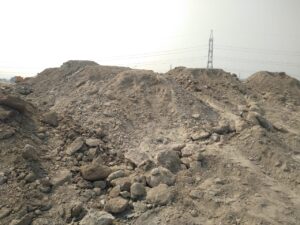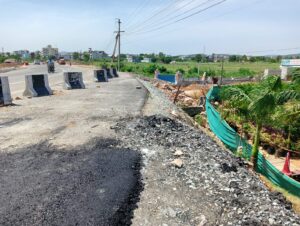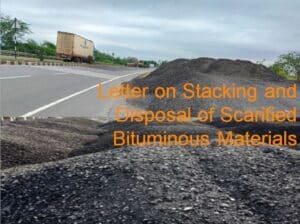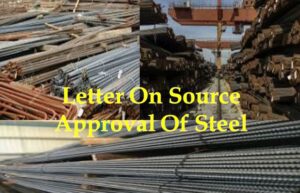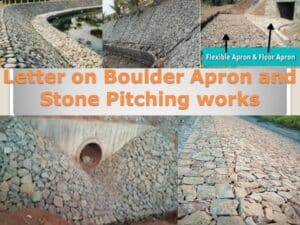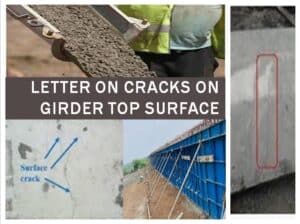Highway construction site inspection following heavy rain
Highway Inspection Following Heavy Rain: The following content relates to an independent engineer’s inspection of a highway construction site following a heavy rain.
This includes a notice letter to the concessionaire by IE. The notice shall describe various observations of lapses and defect findings of inspection. Also, consequential: Urges the concessionaire for repair and rectification actions.
An Overview of the Highway Construction Site Inspection Report
As per Article 13, Clause 13.2 of the CA: Inspection:
- During the construction period of the project highway, the independent engineer shall inspect the project highway at least once a month and prepare an inspection report (“Inspection Report”).
- This report should state in reasonable detail all observations made during the inspection. Such as the defects or deficiencies, if any, with particular reference to the scope of the project and specifications and standards.
Further, as per Schedule Q, Clause 5.3 of the CA:
- The IE must inspect the construction works and project highway once a month. And make out a report of such an inspection.
- In this inspection report, the independent engineer shall set out in reasonable detail the defects, deficiencies, and lapses observed in the construction of the project highway.
- The inspection report shall also contain a review of the maintenance of the existing lanes in conformity with the provisions of the agreement.
- The IE may inspect the project highway more than once a month if any lapses, defects, or deficiencies require such inspections.

A letter notice on the IE Team’s Highway Inspection Following Heavy Rain on July 1, 2024
|
To The Concessionaire, Subject: IE Team’s Highway Inspection Following the Heavy Rain on July 1, 2024-Reg.Dear sir, Following the heavy rain, independent engineer team visited the “Project Highway” on XX/XX/2024, i.e., today, and the following are our observations. Highway Inspection Following Heavy Rain ObservationsObservation 1: Accumulation of water on construction areas
There are a number of work locations where the accumulated water has not been drained out. This condition will disturb the density of these patches. Some examples in Km Chainages: a. 48.900 to 49.000 (RHS) b. 43.500 to 43.600 (RHS) c. 34.300 to 34.400 (LHS). Hence, before taking further works in these patches, the accumulated water must be dewatered. And, followed by drying and compaction of these patches. Observation 2: The exposed top layers
The project construction site exposed the top layers for different types of works in the entire stretch of Project Highway, which were subjected to incessant rain. It needs to be re-compacted before starting further work (where necessary). A number of places, like the following Km chainages:. a. 91.500 to 91.960 b. 98.164 το 98.400 c. 103.000 to 104.00 Observation 3: Spill of black cotton soils on embankment and subgrade materialsWhere embankment and subgrade materials are being stacked after removing the black cotton soil and partially being spread before compacting the same for a considerable period of time, they are being subjected to spillage from excavated black cotton soil stacks next to the trenches. The stacks must be removed with immediate effect and the embankment layers compacted after removing and relaying the same. Observation 4: Oversized lumps of embankment soils
At Km Chainage 109.700 to 109.850, 128+900, 129+220 L/S, it was found that embankment fills were stacked to replace black cotton soils. These stacks contain oversized lumps, which must be removed before spreading. Observation 5: Improper Sequence of Highway Construction
In the Km Chainages: a. 54.000 to 54.170 (GSB layers have been constructed) b. 84.000 to 86.000 (WMM layers have been constructed) We have found that: a. The shoulders were not constructed simultaneously with the main layers. b. Now shoulder materials are being stacked on the corresponding top layers to be spread. During rain, these plastic materials may percolate to the GSB and WMM layers, which will disturb the drainage system. c. For the case of WMM layers (combined thickness of 250 mm), the post-construction of the shoulder in one layer means non-fulfilment of density; hence, chances of rain cut formation will be there. Observation 6: Construction ProceduresIn a number of places, it has been found that GSB layers, which were completed long before, And these are being loosened. At the top portion, which requires further treatment and recompaction before taking WMM layers. Highway Inspection Following Heavy Rain: Conclusion All these points are to be rectified with immediate effect. Thanking you, [Yours,] [Insert the name of the authorised person]. |
Note to a visitor about the Highway Inspection Following Heavy Rain of construction site
It is that a few important and mandatory aspects are only discussed herewith. Kindly note that the above inspection observations are considered examples. You may adopt the gist of the subject and change it to suit the current need. And before using this content in your letter drafting, you need to ensure the specific CA Contractual conditions and other aspects, etc.
It is suggested to read article about the Improper bituminous construction works on Highway project
Also, read about the highway Traffic control and safety during highway project construction and traffic diversion plans on the highway.
Additionally, you can find various sample draft formats for highway operation and maintenance correspondence.
FAQ’s related to Highway Inspection Following Heavy Rain of construction site
The team highway correspondence will update soon.



